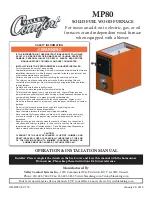
4.3
Tube Life
A ceramic work tube may crack if work pieces are inserted too quickly or at
temperatures below 900 °C (when the tube is more brittle). Large work pieces
should also be heated slowly to ensure that large temperature differences do not
arise.
Poor thermal contact should be encouraged between the work piece and the tube;
crucibles or boats should be of low thermal mass and should have feet to reduce
the contact with the tube (fig. 4).
Key
A
Tube
B
Crucible
Fig 4 - Avoidance of thermal contact
Do not set too high a heating or cooling rate. As tubes are susceptible to thermal shock
and may break. Tubes which extend beyond the heated part of the furnace are more at
risk. A general rule for maximum heating or cooling rate is 400 ÷ internal diameter in
mm to give (°C/ min); for 75 mm i/ d tubes this comes to 5 °C per minute. The
controller can be set to limit both the heating and cooling rate.
4.4
Operator Safety
The ceramic materials used in the product manufacture become
electrically conductive to some extent at high temperatures. DO NOT
use any conductive tools within the product without isolating it. If a
metal work tube is used, it must be earthed (grounded).
Switch off the heater switch whenever loading or unloading the
product. The elements are isolated when the heater switch is OFF.
This switch cuts both sides of the circuit via a contactor.
11












































